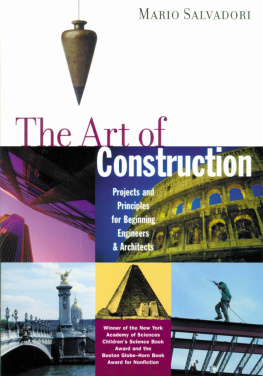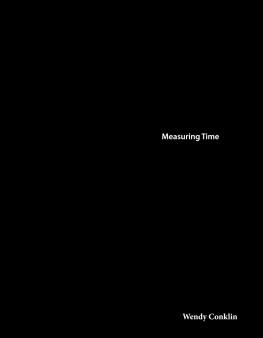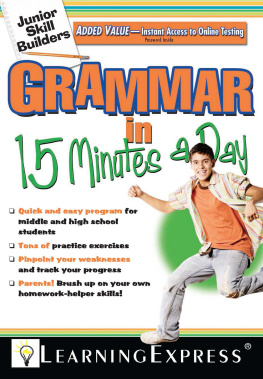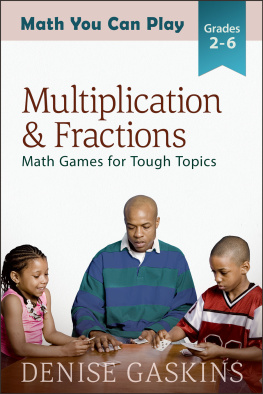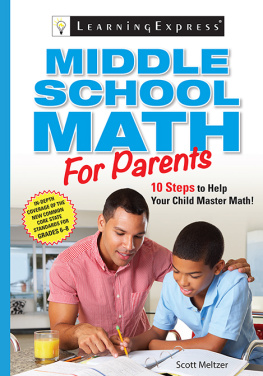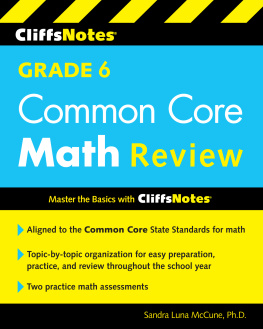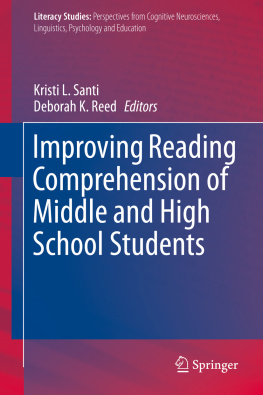Math GAMES FOR Middle School
Challenges and Skill-Builders for Students at Every Level
MARIO SALVADORI and Joseph P. Wright

Library of Congress Cataloging-in-Publication Data
Library of Congress Cataloging-in-Publication Data
Salvadori, Mario George, 1907-1997
Math games for middle school: challenges and skill-builders for students at
every level / Mario Salvadori and Joseph P. Wright.
p. cm.
Summary: Uses explanations, word problems, and games to cover some mathematical topics that middle school students need to know, including the invention of numerical notations, basic arithmetical operations, measurements, geometry, graphs, and probability.
ISBN 978-1-55652-288-8
1. MathematicsStudy and teaching (Middle school) 2. Games in mathematics
education [1. Mathematics. 2. MathematicsProblems, exercises, etc.]
I. Wright, Joseph P. 1939-. II. Title.
QA135.5.S233 1998
510.712dc21 97-51422
CIP
AC
1998 by Mario Salvadori and Joseph P. Wright
All rights reserved
Published by Chicago Review Press, Incorporated
814 North Franklin Street
Chicago, Illinois 60610
ISBN 978-1-55652-288-8
Printed in the United States of America
To Maia and Daniel, who discovered big numbers at age two.
Preface
This book was written
Because I hated math in school and it took a Ph.D. to make me love it;
Because math is as beautiful as poetry and as useful as water;
Because children are not retarded adults; while, sometimes, adults behave like retarded children;
Because in our country even intelligent people boast that they hate mathematics and they will never understand it.
and
To make it easier for teachers to teach math and for students to learn it;
To show our students that math is a fascinating human invention;
To satisfy the growing demand of our culture for more and more advanced math, science, and technology;
And finally
To thank all my students, from kindergarten to Ph.D.s, who for 64 years have given me the joy of explaining to them what mathematics really is.
Mario Salvadori
Acknowledgments
I wish to express my deep gratitude to:
Joe Wright, a first-rate mathematician and real friend who has read the typescript of this book, patiently prepared the solutions for the problems in each Math Camp, and done all the illustrations on the computer. I hereby thank him for his help and exonerate him for any and all mistakes due to me.
My wife Carol, who translated my English-Italian into pure American.
Dr. Lorraine Whitman, the executive director of the Salvadori Educational Center, for her editorial help.
Mr. Bennett Viseltear for his editorial suggestions and his patience in typing the early versions of this book.
Linda Matthews, master editor, and her able staff at Chicago Review Press, for their skill and dedication.
Tracey Wright, curriculum developer at TERC, Cambridge, Massachusetts, for her editorial help.
Ms. Caroline Daviews, mathematics teacher, and Mrs. Evelyn Wiesfield, director of the Booker T. Washington Minischool, and Mr. Jules Linden, the superb principal of the Booker T. Washington Magnet School 54 in District 3 of the New York City Board of Education, for their support of my lectures in their school for many terms.
And last but not least, the sixth- and seventh-grade students of the Booker T. Washington Minischool for their enthusiasm and their creative suggestions.
Contents
Chapter One
The Invention of Numbers
Chapter Two
Adding, Multiplying, Subtracting, and Dividing Numbers
Chapter Three
More Operations on Numbers
Chapter Four
Measurements
Chapter Five
Plane Geometry
Chapter Six
Space Geometry
Chapter Seven
The Art of Graphing
Chapter Eight
Simultaneous Linear Equations
Chapter Nine
Permutations And Combinations
Chapter Ten
The Mathematics of Chance
Answers
Answers to Math Camps
Introduction
This book is the result of my own education and teaching experience, both rather unusual.
For the last 20 years I have taught in New York City and indirectly (through the materials of the Salvadori Center) all over the United States and in some foreign countries. The Salvadori Center is dedicated to improving teaching in middle schools, with particular emphasis on math and science (though its methodology is applicable to all subjects). So far, The Salvadori Center has reached over 120,000 students in New York City alone, dramatically reducing the dropout rate from the 40%-plus common in our town.
Prior to my interest in the public schools, I taught on the faculties of Columbia University for 50 years and Princeton University for five years. And, at the beginning of my university career, I was on the faculty of the University of Rome, my native city, for eight years.
My Italian education ended with one doctorate in mathematical physics and another in civil engineering. My 50-year professional career in the United States was dedicated to structural engineering design and to consultation in applied mechanics problems. I have dedicated the last years of my life entirely to teaching the young, from kindergartners through high schoolers.
I dedicate this book to all the wonderful teachers and students it has been my good fortune to meet in our schools. On the basis of this experience, I am eager to share my pedagogical approach to teaching. It consists of these elementary rules:
I teach young students with the same respect I taught Ph.D. students.
I present the curriculum, whatever the subject, through realistic examples from the students own world.
Whenever possible, I get the students interested by means of hands-on work involving easily built models.
I ask to be called Mario and to be interrupted whenever one of my statements is not clearly understood by anyone in class, having discovered that respect comes from appreciation rather than from authority, and that what is not clear to one student, most of the time is not clear to many.
I have tried to show that elementary mathematics is a fascinating fruit of the human spirit and not a series of mysterious rules dropped on us from the sky. Mentioning the names of the inventors of math makes mathematics as human and interesting as the humanities.
Although Italian by birth and education, I have not considered the study of Roman numerals essential to the education of American students. And, although a scientist, I have not considered it necessary to deal with some of the higher concepts of mathematics in middle school.
I have tried to satisfy the sixth-grade requirements of the Board of Education of New York City, which are similar to those of most boards of education in the United States.
I hope my colleagues in middle schools will have as much fun teaching mathematics according to these tried rules as I have had in teaching both the elementary and the advanced concepts of math.
Good luck!
Mario Salvadori
Postscript
This book is just one of several projects that Mario was working on when he died in June of 1997 at the age of 90. On several occasions, usually when we met to discuss the book, he asked me the same question he liked to ask his students, Are you having fun? I naturally said yes, both because I enjoy mathematics and I enjoyed being with him.


